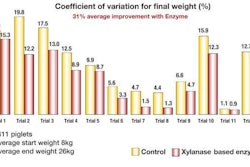Mineral management for high-yielding dairy cows has returned to the spotlight in Denmark with the launch of a feed supplement claimed to prevent up to 80 percent of milk fever cases. Soon to be marketed in a form for top dressing the cow's regular feed before calving, the supplement aims to influence the ability of the animal to absorb calcium into her bloodstream at the onset of lactation.
Development work for the product was done at the Faculty of Bioscience, Copenhagen University (formerly the Royal Veterinary and Agricultural University). The commercial version made its debut at the Agromek exhibition held in Denmark in January 2008, when Vitfoss A/S premixes and minerals arm of Danish feed manufacturer DLG launched it under the product name of X-Zelit.
Common problem in dairy
"We see milk fever as quite a common occurrence in Danish dairy herds," commented company agronomist Kaj Andersen. "There are 550,000 cows in this country and 5 to 6 percent of them on average will encounter milk fever problems when they calve. This overall average rate is about the same as reported from other countries. We also share the experience that cows in their first or second calving are not affected.
But from the third calving onwards, the rate can be between 10 and 20 percent. A few farms even have difficulties in 30 percent of their older cows. "When a clinical case occurs, it is important that the farmer calls for veterinary help as soon as possible, otherwise the cow may die. It is now clear that many more cows can have subclinical milk fever. Some reports from other countries say up to 50 percent of cows could have the condition subclinically. So it pays to apply methods aimed at prevention to all the cows in the herd."
Milk fever occurs around the time of parturition whenever the adult cow fails to replace all of the calcium she has passed into colostrum or milk, either from the minerals in her feed or by drawing on the reserves present in the bones of her body. Low blood calcium, or hypocalcaemia, to some degree affects almost all cows around calving, although its effects may not appear until several days after the calf has been born. Studies have also shown consistently that even quite large increases in dietary calcium in late gestation will not affect the hypocalcaemia of the cow at calving. Prevention depends on mobilising her skeletal stores and ensuring these are absorbed effectively.
This mobilisation starts if a drop in blood calcium concentration triggers the production of a parathyroid (PTH) hormone, while absorption of the mineral is stimulated by a hormonal derivative of vitamin D.
These observations have offered the basis for possible control of milk fever risk by dietary means. For example, the functioning of PTH, and therefore the supply of calcium to replenish the blood concentration, is better when the metabolism of the cow is in a state of acidosis than in alkalosis. The metabolic state can hinge on whether her blood has absorbed more minerals with a positive electrical charge (cations) than those that are negatively charged. The typical cations are calcium, magnesium, sodium and potassium whereas examples of anions are phosphate, sulphate and chloride salts. Unless the cation-to-anion ratio is balanced, there may be an excess of cations that raises the pH of the blood to an alkaline level. Unfortunately, it also seems true that giving extra anion salts to restore the ratio can lead to problems of palatability.
Limiting calcium
Another preventive strategy limits the calcium supply to the cow for some weeks before calving so that her blood concentration decreases and therefore an early secretion of PTH is stimulated. Having extra PTH in circulation for this period should overcome the hormone function drawbacks associated with alkalosis by the time of parturition. The problem in practice has been how to supply less calcium than the cow needs in the few weeks at the end of her gestation.
A so-called Calcigard approach pioneered in New Zealand has taken the route of restricting the initial availability of calcium to the cow. It uses a feed supplement based on soybean oil to bind calcium in the gastro-intestinal tract into a poorly digested insoluble form. Supplementation for about three weeks in late pregnancy aims to ensure that less calcium is available to the animal before calving, so her blood concentration falls. Accordingly, she should be better at mobilising the mineral from her bones and absorbing it into her blood when the calf is born and the colostrum/milk demand begins.
As a presentation to the Agromek show in Denmark revealed, placing a limit on calcium availability is also the idea behind a method that employs tiny crystals of silicate. Vitfoss in its introduction of the X-Zelit product explained that the synthetic sodium aluminosilicate (zeolite) material is full of sodium ions. Inside the rumen, it supports an exchange whereby the calcium present is bonded and the sodium is released. Once again, therefore, the intended outcome is that the cow's hormone system is stimulated to pull calcium from the skeleton so her bloodstream contains enough to keep step with the amount taken by the start of lactation.
The earliest research into the method had suggested that a large daily intake of zeolite would be required and this could interfere with the absorption of other minerals.
But the Danes say their latest version works with an intake of 770 grams per cow per day in the last 14 days before calving, with the material top dressed on regular feed. Product development has also led to improvements in palatability, with most dairy cows accepting it.
Gaining European Union approval
Marketing such a product in Europe must have European Union (EU) approval. Official authorisation for use in the EU-27 countries was made more likely by a mid-2007 opinion from the feed additive safety panel advising the European Commission. It said that using zeolite as a calcium binder to reduce the risk of milk fever in dairy cows did not pose a threat to animal health or to the environment. A submission presented to the commission had requested the use of a synthetic sodium aluminium silicate with a high cation-exchange capacity for feeding to pregnant dairy cows at 500 to 1,000 grams/day during the last two to four weeks before parturition, subsequently reduced to 500 grams for two weeks.
Agromek visitors heard that the Danish formulation of synthetic zeolite had proven highly effective preventing milk fever and hypocalcaemia in the newly calved cow. Some years ago, Professor Rolf Jørgensen in Denmark developed the hypothesis that a cow would be better prepared for the massive withdrawal of calcium from the blood to the udder soon after calving, if her natural defenses against hypocalcaemia could be activated earlier. But how to achieve the negative calcium balance believed to be necessary to trigger this mechanism, when the daily calcium requirement of a dry cow is lower than her intake?
His research group in Copenhagen tried adding aluminium silicate powder to the feed. A water softener used in the food industry, the powder has a known sodium-calcium ion exchange capability which was considered applicable for binding calcium in the cow and so making the mineral less bioavailable. The Danish version now near marketing is called a special formulation of synthetic zeolite for application in feeds during the period from two weeks before the expected date of calving. Besides a reduction in calcium availability, it has decreased the inorganic phosphorus in the blood, increasing the product's efficacy.
Some studies have indicated 100 percent success in preventing milk fever and subclinical hypocalcaemia. The developers also reported results of a recent trial involving 259 calvings on 22 farms. A 28.4 percent level of milk fever was recorded for untreated cows, compared with 6.9 percent for those in the treatment group. The reduction reached 80 percent among cows deemed high-risk because they were at their third calving or older.



.jpg?auto=format%2Ccompress&fit=crop&h=167&q=70&w=250)
.jpg?auto=format%2Ccompress&fit=crop&h=167&q=70&w=250)












